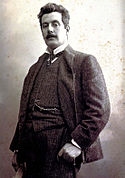Madame Butterfly - 'Exit Yamadori', by Byam Shaw
Identifier: favouriteoperasf00hadd (find matches)
Title: Favourite operas from Mozart to Mascagni : their plots, history and music
Year: 1910 (1910s)
Authors: Hadden, J. Cuthbert (James Cuthbert), 1861-1914
Subjects: Operas
Publisher: New York : Thomas Nelson
Contributing Library: Harold B. Lee Library
Digitizing Sponsor: Brigham Young University
View Book Page: Book Viewer
About This Book: Catalog Entry
View All Images: All Images From Book
Click here to view book online to see this illustration in context in a browseable online version of this book.
Text Appearing Before Image:
apanese marriage and allthe gaiety and bustle of the ceremony and reception.It is repeated again and again until Goro begins toenumerate the guests, when he is accompanied by adelightful figure, suggestive of their short trippingstep, a figure which is heard later on as the relativesarrive. The first of the party, Sharpless, is introduced bya tuneful phrase, throughout associated with the ^F5= ) :. (Shar) Dless). ^*^p-H *-^J -1—■^■ ;t=- E^^ Consul, and descriptive of his kindly, sympatheticnature. After Pinkerton has commented upon theelastic nature of Japanese houses and contracts, hesings a suave strain characteristic of his easy-going,optimistic temperament. The opening phrase in theorchestra will be recognised as the melody of The 2. (Pinkerton). *^ y f-^ trtf=:;zp (fl) Star-spangled Banner. It is heard several times inthe course of the work, when Pinkertons nationalityis referred to. That his convenient gospel may havefatal consequences, Sharpless points out in a phrase 216
Text Appearing After Image:
Exit Yamadori THE MUSIC that recurs in the last scene, where the Consul isjustified in his philosophy : -^ -«- -iif- 3^5s ^-d During Goros absence, Pinkerton describes howhe has been fascinated by the little Japanese girlin a dainty, piquant melody, set out with delicatetouches of orchestration, suggestive of her grace andbutterjfly-like charm. A second time Sharpless warnshim, now in the following themes, also heard in thesecond Act, telling him that this child is not to be 3, (Warning), (a) K ifat ^^^#-f TX (6) 5: 3 -ir^-i m-^—G- trifled with. He drinks to Pinkertons friends andrelatives at home, to the accompaniment of thewarning motive (3a), and when the Lieutenant alsoraises his glass to his future American wife, thephrase (36) continues the timely advice. Now Gororeturns, announcing the approach of the bridal party.He sings a quaint Japanese phrase that forms anaccompaniment to the first strains of their voices,heard in the distance, then nearer, and at last in 217 FAVOURITE
Note About Images
Relevante Bilder
Relevante Artikel
Madama ButterflyMadama Butterfly ist eine Oper von Giacomo Puccini. Das Libretto stammt von Giuseppe Giacosa und Luigi Illica. Es basiert auf der Erzählung Madame Butterfly (1898) von John Luther Long und der Tragödie Madame Butterfly. A Tragedy of Japan (1900) von David Belasco. Die Oper wurde in ihrer ursprünglichen Fassung als Zweiakter am 17. Februar 1904 im Teatro alla Scala in Mailand uraufgeführt. Die erste Sängerin der Titelpartie war die von Puccini verehrte Sopranistin Rosina Storchio. Die Uraufführung der dreiaktigen Neufassung fand am 28. Mai 1904 in Brescia statt. .. weiterlesen








